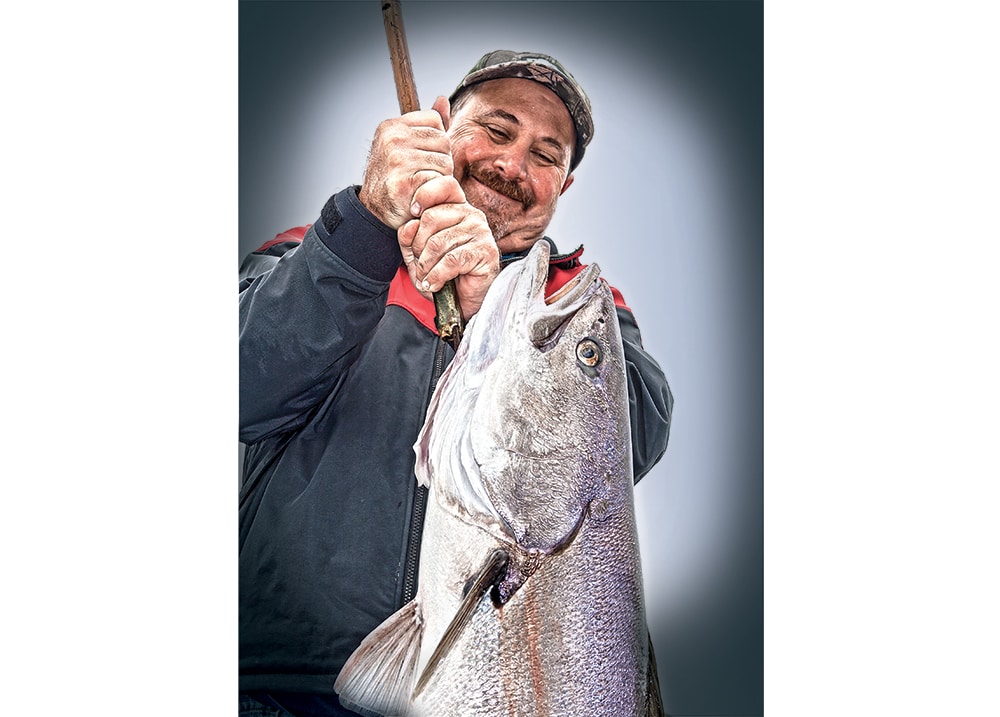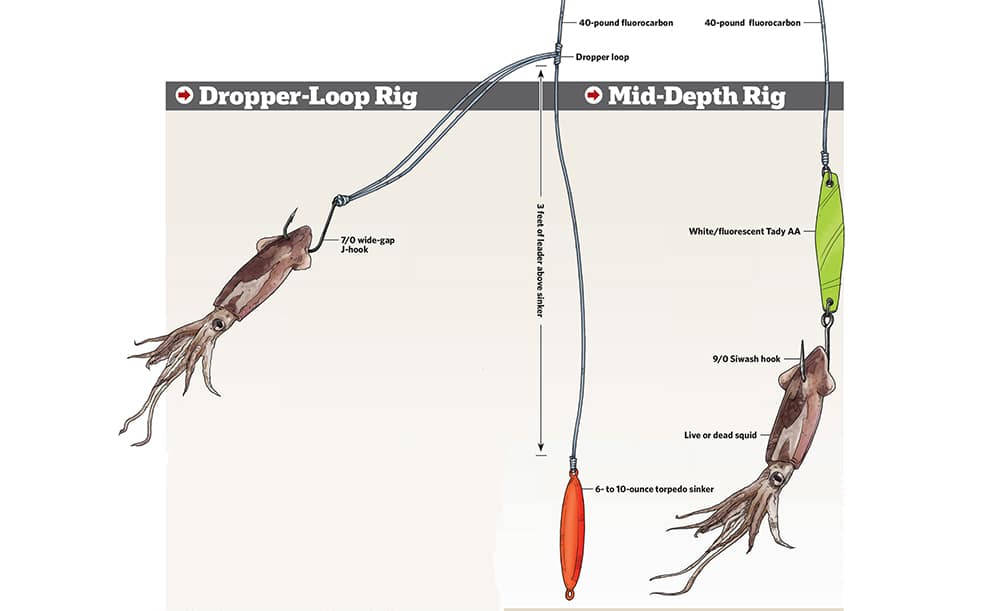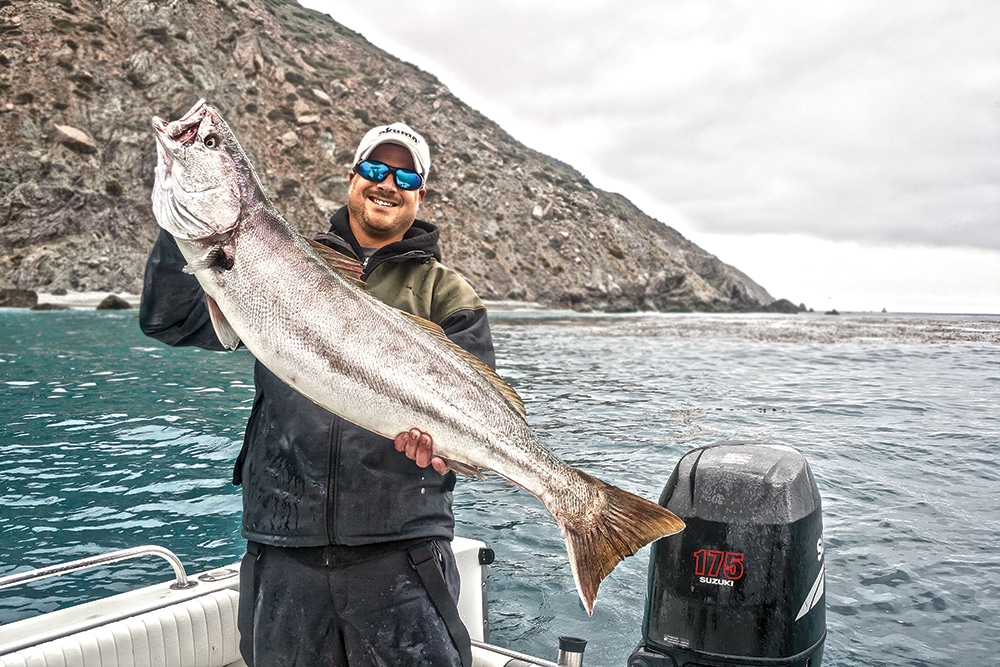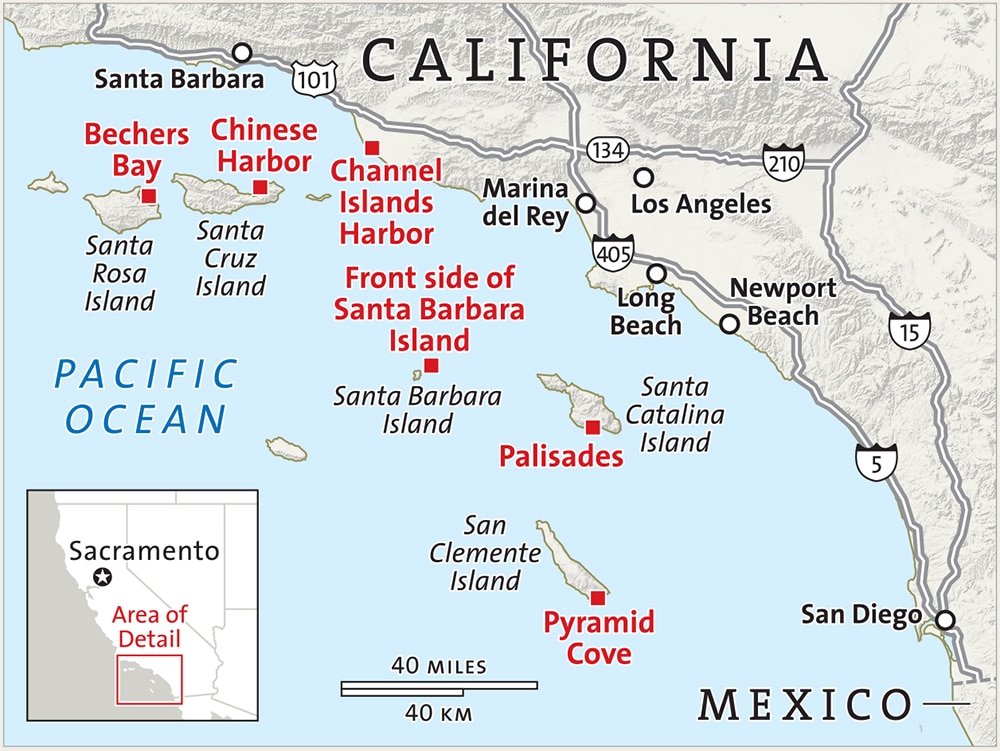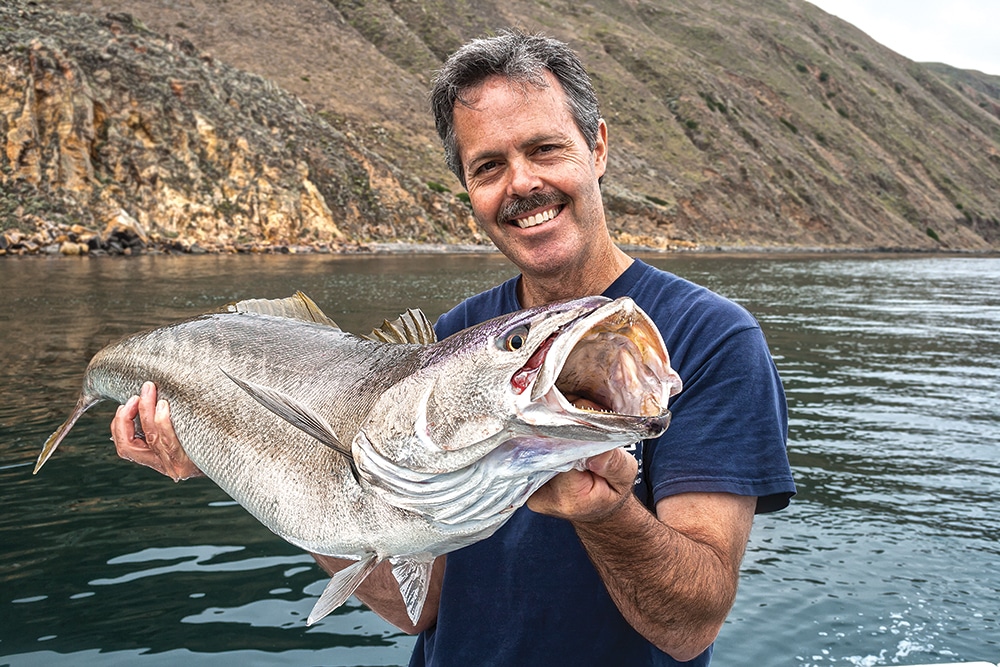
California’s offshore islands provide outstanding fishing for a great many species at different times of the year, and the white seabass is one of the favorites of SoCal fishermen. The seabass arrive around the islands with the market squid, and the specialized techniques described here will help you catch them.
A blanket of clouds shrouded the hills of San Clemente Island, some 50 nautical miles off the coast of Southern California, as Capt. Gary Adams positioned his 50-foot six-pack charter boat, Rail Time, outside a kelp bed. “Let’s see if those seabass are biting,” he said, as the crew dropped anchor and anglers cast live squid toward the kelp.
Within seconds, the first angler hooked up, then another and another. And so it went for the next 45 minutes. By the end of the frenzy, all six anglers had caught their three-fish limits, and it was only 8:00 a.m.
Fish the right place at the right time, and the action can be fast and furious on white seabass that regularly reach 50 pounds, and seem to be growing larger each season.
Good skippers know signs that indicate that white seabass are feeding, whether at Santa Rosa, Santa Cruz, Santa Barbara, Santa Catalina or San Clemente islands. Each island has its own characteristics. But they also share indicators, in particular, the presence of opalescent (aka “market”) squid.
Squid Grounds
The first place to start looking is on the squid grounds — sand- and mud-bottom areas in 90 to 120 feet of water where the squid go to spawn at night.
While squid might show up anywhere, traditional squid grounds include Bechers Bay at Santa Rosa Island, Chinese Harbor at Santa Cruz Island, the front side of Santa Barbara Island, the Palisades at Catalina Island, and Pyramid Cove at San Clemente Island.
Light boats — commercial squid fishermen who follow the squid — rank as the most obvious indicator.
The fish finder helps you pinpoint squid nests on the bottom where squid have been laying their translucent egg sacs, which show up on a fish finder as a light-blue fuzz. Squid usually return to a nest each night, so if you find a nest, anchor over it.
After Dark
As darkness falls, your goals are first attracting squid, then attracting white seabass. Attracting squid takes on even greater urgency if you don’t already have frozen or live squid in the bait tank.
Live squid are sold from live-bait barges in Channel Islands Harbor, Marina del Rey, Long Beach and Newport Beach; or you might find bait boats selling them at the Channel Islands or Catalina. If you find live squid being sold, buy some (usually $60 per scoop), as catching your own isn’t guaranteed.
White seabass will readily eat fresh-frozen squid, so bring some as insurance. To attract your own live-squid bait, put out an underwater light, such as the 12-volt Hydra Glow LED submersible fish light. The two-foot model draws 1 amp, yet puts out a bright-green glow that attracts squid. If the school comes to the surface in sufficient numbers, use a long-handled fine-mesh dip net to fill the livewell.
Sometimes squid hang below the boat, beyond reach of a dip net. This is when anglers employ a crowder, such as the Pacific Edge PE56M — a wide, flat fine-mesh net with a telescoping pole on each end. With a man on each pole, the crowder is lowered straight down, then pivoted outward and lifted to the surface to capture squid.
When squid refuse to come up, squid jigs are employed to catch enough bait for fishing. Among the most popular jigs today are the 3-inch Izorline Lighted Squid Jig and the Ahi Squid Catcher, which includes five small jigs on a gangion. The hooks are more like barbless spikes, which entangle the squid’s tentacles and also make it easy to unhook them.
ISLAND SEABASS CALENDAR
February-April: Fair
May: Good
June-August: Excellent
September-October: Good
November-December: Fair
Night Bite
Once you’ve baited up, it’s a good idea to leave the underwater light on, as the more squid in the water, the more likely a school of seabass will come to investigate.
Anglers used to fish with bottom rigs exclusively, but in recent years, it has become clear that white seabass often feed close to the surface at night. Savvy anglers cover the water column with baits.
Typically, this includes a dropper-loop rig with a 7/0 wide-gap J-hook, such as a Lazer Trokar TK10, tied three feet above a fluorescent 6- to 10-ounce torpedo sinker, set a few cranks off the bottom and fished from rod holders in the bow. To cover the mid-depths, dangle a white jig, such as a Tady AA (with fluorescent paint on one side), with a single hook and one or two squid pinned on. These are best fished from rod holders just forward of the transom.
Anglers fishing from the transom usually fly-line squid or use a balloon to hold the bait near the surface. White seabass rarely swim close to the boat, so present the surface bait just outside the glow of the underwater light.
Darkness adds to the difficulty factor when battling these big, powerful fish. To reduce the chaos, get all the deck lights on, clear the other lines, and get the rods away from the rail.
Relatively heavy tackle also helps maintain control — 40-pound mono is minimal. White seabass are not particularly line shy, especially at night. The heavy tackle allows for very tight drags, to help keep fish close to the boat and as vertical as possible. Seabass have a decent set of sharp teeth, so the heavy line also helps prevent the fish from biting off.
Action on the squid grounds sometimes extends into the morning hours, and some of the best fishing can take place between first light and sunrise. But you can’t count on it. Too many times, anglers show up in the gray only to learn that the bite happened hours earlier.
Kelp Lines
Daytime fishing can pay off once the fish retreat to the shadows of the kelp beds. White seabass are more likely to venture out of the forests when there’s current. These were the conditions Capt. Adams recognized last July aboard Rail Time.
Some of the best days for current are around a new or full moon.
Another prime indicator is a milky color break extending from the edge of the kelp, particularly at Catalina. White seabass tend to travel and feed along these breaks on their daytime forays outside the kelp.
Submerged kelp fronds might extend out into the deeper water, so it’s important to stay well outside the kelp line. Get in too tight, and you might have a difficult time landing a 50- or 60-pounder that powers its way back into cover.
Covering the water column with a combination of bottom rigs, metal jigs in the mid-depths, and surface baits is a good idea too, even though the water here is usually shallower than on the squid grounds.
You can use the same tackle as on the squid grounds, but many anglers like to add a “kelp-cutter” outfit to their arsenal when fly-lining or fishing with a balloon. This consists of 65-pound-test coated Spectra with a 2- or 3-foot 40- to 50-pound fluorocarbon leader, attached with an Albright or uni-knot splice.
With this type of abrasion-resistant combintaion, you’re able to slice through the stalks of kelp should a seabass bully its way into the weeds. This technique works best if you back the drag off a bit so the line saws its way through the kelp. Once the fish is clear of the weeds, tighten up again, and don’t back off until it’s on the gaff.
That’s the way to make the most of island time.
Tackle Box
Baits and Rigs: Live, fresh-dead or frozen market (opalescent) squid, fished one or two at a time on a hook
Rods: 8-foot medium-action rods
Reels: Small, fast, lever-drag reels such as Okuma Cedro 10 or Penn Squall 30LD
Line: 40-pound-test monofilament; or 65-pound-test coated braid with a 3-foot, 40- to 50-pound fluorocarbon leader
Terminal Rig: Lazer Trokar TK10 7/0 hooks, dropper loop three feet above a 6- to 10-ounce fluorescent torpedo sinker. For surface fishing, use a sliding egg sinker from 1⁄8 to 1 ounce above a 7/0 hook; the same rig can be fished with a balloon about six feet above. For the mid-depths, fish a white/fluorescent Tady AA fastened to a 9/0 single Siwash hook.
Planner
What: White seabass
Where: Squid grounds and kelp beds along Santa Rosa, Santa Cruz, Santa Barbara, Santa Catalina and San Clemente islands.
When: May through August
Who: Boating anglers with reliable craft from 20 feet up. Here are four top six-pack charters:
- Capt. Gary Adams, Rail Time, gary@adamsservices.com
- Capt. Tony Saldivar, MarDiosa, 949-305-0165, www.mardiosasportfishing.com
- Capt. Tino Valentine, Options, 562-980-2009, www.optionssportfishing.net
- Capt. Allyn Watson, Dreamer, 562-394-8602, www.dreamerfishing.com
